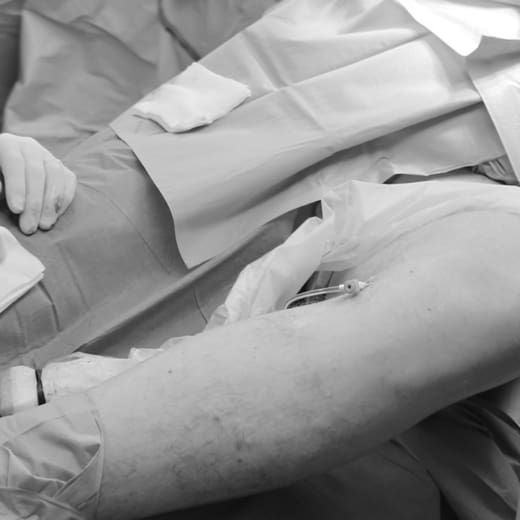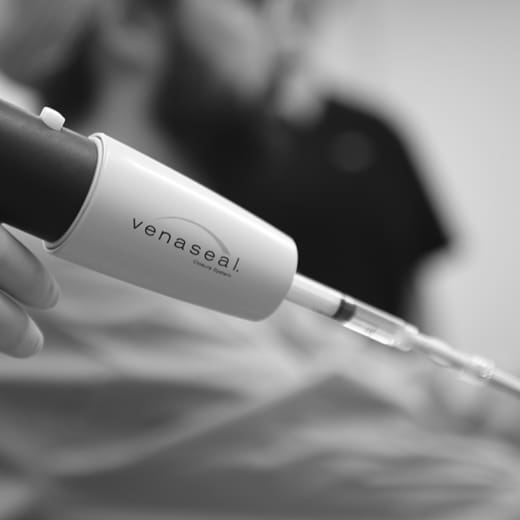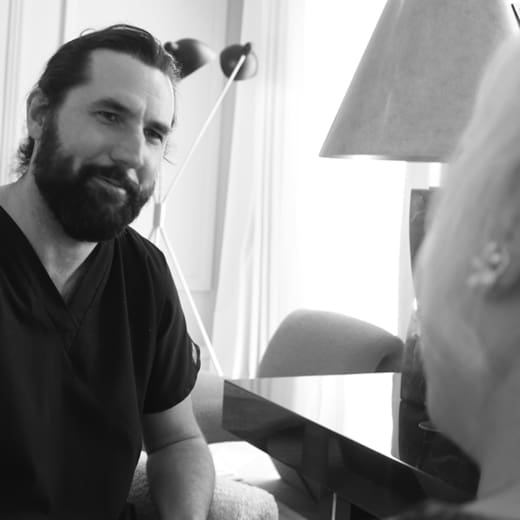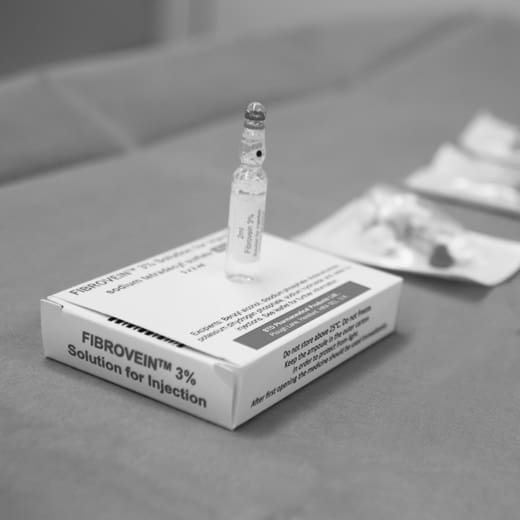McKeown Medical
167 Bath Street, Glasgow, G2 4SQ
Varicose veins are enlarged, twisted veins that often appear just under the skin, primarily in the legs and feet.
Date posted — 7.10.24
Varicose veins are enlarged, twisted veins that often appear just under the skin, primarily in the legs and feet. They can be blue, purple, or flesh-coloured and are often raised, giving a bumpy or rope-like appearance on the skin’s surface. These veins develop when the valves in the veins that regulate blood flow become weakened or damaged, causing blood to pool and the veins to enlarge.
While varicose veins are generally more common in older adults, women, and those with a family history of the condition, factors such as prolonged standing, obesity, and pregnancy can increase the risk.

The symptoms of varicose veins can range from mild to severe. Some people may experience aching, heaviness, or cramping in the legs, particularly after standing or sitting for extended periods. The affected area might also feel itchy or develop a burning sensation.
In more severe cases, varicose veins can lead to swelling, throbbing, and even skin changes, such as discolouration or the development of ulcers near the ankles. The condition is not only a cosmetic concern but can also cause discomfort and, in some cases, lead to more serious circulatory problems.
The best treatment options for varicose veins depend on the severity of the condition, the symptoms experienced and the anatomy of the problematic veins. A detailed clinical review by an expert vascular surgeon along with a detailed ultrasound scan will delineate the optimal treatment.
For mild cases, lifestyle changes can be effective in managing symptoms. These include regular exercise to improve circulation, elevating the legs when resting, and wearing compression stockings, which help to reduce swelling and discomfort by improving blood flow in the affected veins. Weight management and avoiding prolonged periods of standing or sitting can also alleviate symptoms and prevent the condition from worsening.
For more severe cases or when lifestyle changes are insufficient, medical treatments may be necessary. Sclerotherapy is a common procedure where a solution is injected into the varicose veins, causing them to collapse and eventually fade. This is most suitable for smaller veins, just below the surface of the skin.
The next level of treatment is endovenous treatment, which means operating inside the problematic veins to cause them to collapse. Traditionally this has been done using either laser or radiofrequency energy to close the affected blood vessels down.
More recently, the VenaSeal™ procedure has been introduced. This is an even less invasive option which uses a special glue to close the veins down.
In cases where these treatments are ineffective or unsuitable, invasive surgical options like vein stripping or phlebectomy may be recommended to remove or tie off the affected veins.
Consulting with an expert vascular surgeon is essential to determine the most appropriate treatment plan based on your individual needs and the severity of your condition.
Dr Alex Vesey is our expert consultant vascular surgeon who heads up our varicose vein team. Listen to him explain your options for varicose vein treatment.

Varicose veins can theoretically happen anywhere on the body, but most commonly affect the veins on the legs. To specifically target and remove varicose veins in the legs, several treatments are available.
Endovenous laser treatment (EVLT) and Radiofrequency ablation (RFA) are minimally invasive procedures that remain very popular because they avoid the need for traditional surgery. Both procedures are performed under local anaesthetic and involve inserting a thin tube inside the vein and destroying the vein by delivering heat to close the vein down. Both of these treatments offer a high success rate with less discomfort and scarring than traditional surgery.
The newer VenaSeal™ procedure causes even less discomfort by closing the vein using glue, rather than heat. This allows patients an even more rapid return to normal activities, without the need to wear compression stockings.
For veins that are not suitable for these treatments, sclerotherapy is a widely used option, especially for smaller varicose veins or spider veins in the legs. During sclerotherapy, a solution is injected directly into the vein, causing it to collapse and gradually be absorbed by the body. Multiple sessions may be required depending on the extent of the varicose veins.
An alternative treatment for smaller veins is a minor surgical procedure called microphlebectomy. This involves making tiny incisions under local anaesthetic to remove problematic veins. While slightly more invasive than sclerotherapy injections, microphlebectomy can be very effective because it physically removes the vessels which means they cannot come back.
Consulting with an expert vascular surgeon is essential to choose the most appropriate treatment based on the specific characteristics of the varicose veins in the legs.
Spider veins are small, web-like veins often associated with varicose veins. To treat these, several effective treatment options are available.
Sclerotherapy is the most common and widely used method. In this procedure, a solution is injected directly into the spider veins, causing them to collapse and fade over time. The body gradually absorbs the treated veins, leading to an improved appearance. Sclerotherapy is minimally invasive, typically requires no anaesthetic, and can be done in the outpatient clinic. Multiple sessions may be needed depending on the size and number of spider veins.
Another popular treatment for spider veins is laser therapy. This approach uses focused light energy to target and heat the affected veins, causing them to collapse and eventually disappear. Laser therapy is particularly effective for small, delicate veins that may not be suitable for sclerotherapy. The treatment is non-invasive, and while some patients may experience mild discomfort during the procedure, it generally requires no downtime. In addition to these treatments, maintaining healthy lifestyle habits, such as regular exercise, weight management, and avoiding prolonged periods of standing, can help prevent the development or worsening of spider veins.
If you’d like to find out which varicose veins treatment is the right treatment for you, the first step is to fill out our online consultation form. From there, our team will be able to arrange an initial consultation and ultrasound scan and we can work together to create a treatment plan that is tailored to your needs.

When it comes to treating varicose veins, VenaSeal™ has emerged as a revolutionary option that offers a minimally invasive and...

Radiofrequency ablation (RFA) and endovenous laser ablation (EVLA) are two minimally invasive treatments used to effectively treat varicose veins, but...

Foam sclerotherapy is an advanced form of sclerotherapy used to treat larger varicose veins, particularly those that may not respond...
1 / 3
2 / 3
3 / 3

When it comes to treating varicose veins, VenaSeal™ has emerged as a revolutionary option that offers a minimally invasive and...

Radiofrequency ablation (RFA) and endovenous laser ablation (EVLA) are two minimally invasive treatments used to effectively treat varicose veins, but...

Foam sclerotherapy is an advanced form of sclerotherapy used to treat larger varicose veins, particularly those that may not respond...
Introducing CoolSculpting® Elite!
We’re delighted to announce that we now have the CoolSculpting® Elite, modelled here by our lovely nurse Niki! We’re excited to be the first clinic in Scotland to take delivery of the latest technology from CoolSculpting®, which has new and improved applicators to improve the contact between the machine and the skin, for even better results than before.
Now is the perfect time to have this treatment in time for the summer. To find out more about CoolSculpting® check the link in our bio.

We announced our hair transplant clinic with Dr Mani last week and we`ve been overwhelmed with bookings! We have one space left for this month`s consultation day on the 4th April so if you, or someone you know, would like to book in drop us a message or email [email protected].
Dr Mani is based in London and has a reputation for outstanding hairline restoration and will be joining us once a month to bring his expertise to our clinic.
If you`d like to know more about the procedure, you can read more at the link in our bio.

As everyone knows, the lack of protections in Scotland for patients having cosmetic procedures is something I have campaigned on for years.
It’s an issue that I feel very passionately about and will not stop campaigning on until we have meaningful change from our government. I have written to the government many times over the years and during the recent consultation I wrote to the minister for public health, Jenni Minto, on behalf of 20 of the most experienced doctors in aesthetic practice from all across Scotland explaining why - in very clear scientific terms - she has got it wrong with her current proposals to allow beauty therapists to continue injecting medicines and administering medical devices.
We have asked Jenni Minto to meet with us, to hear our perspective, but she continues to refuse to sit down and talk to us. In tonight’s STV news Donna has been exceptionally brave to speak on camera about the harm she has suffered as a result of a beautician, and the NHS care she has required, but sadly she is not alone.
There are so many Donnas who have been harmed in Scotland and we hear about it every day in our clinics across the country although the majority are too scared or embarrassed to speak out publicly and the government don’t want to listen to the professionals.
Whilst people like Donna continue to be harmed by the diabolical lack of regulation in Scotland, I will not stop campaigning. The government needs to act now to make injectable toxins and dermal fillers medic-only, bringing us in line with every other country in Europe, every state in America and every state in Australia.
Why don’t our government believe people in Scotland deserve the same protections as all of these other countries?

We have another exciting new launch in the clinic - and this one is for the men, or husbands, brothers AND sons!
We are bringing back hair transplant to the practice, performed by Dr Manish Mittal. Dr Mani is based in London - where he has a reputation for outstanding hairline restoration - and will be bringing his expertise to Glasgow every month in our clinic.
These are some examples of Dr Mani’s work. As you can see, he is not only great at creating natural looking hairlines - but also achieving full looking density, which is a rare skill in hair transplant and one of the key reasons we selected him to be our hair transplant partner.
If you (or someone you know!) would like to come in for a consultation and meet Dr Mani, send us a message, email us at [email protected] or call the clinic on 0141 370 0509.

In case you missed it, here’s Dr Rhona & Dr Iain’s live Q&A on all things perimenopause, menopause and HRT. Thanks to everyone who joined and asked questions. We’ll be doing more of these so keep an eye out for the next one!
And if you’d like to know more about our menopause services, check out the link in our bio!

We`re going live tonight at 7pm! Join Dr Rhona and Dr Iain (@driainmartin) this evening on Instagram live, where they`ll be discussing everything about perimenopause & menopause, including: �
Symptoms & early signs
Treatment options, including HRT
Myths vs facts - getting the right information
They`ll also be answering your questions live, so if there`s anything you`d like to ask, leave a comment, send us a message or head to our stories.
We hope you can join us!

Crepey skin under the eyes is one of the most common complaints we hear of in the clinic.
The best way to treat it is using laser resurfacing. This is one of our patients just one week out from treatment. He healed exceptionally fast (most people still have a bit of redness at this stage) and is already looking great.
What do you think?

The nose can be one of the most challenging parts of the face to get right.
This lovely patient had a previous rhinoplasty, but she felt it was over done, making it too short and upturned. I used some filler to restore some height to the bridge of the nose as well as lengthen and de-rotate the tip.
She is over the moon with the result, which looks much more natural than the previous surgery. What do you think?

Happy International Women’s Day! Today, our incredible women’s health team are in the Herald talking about access to women’s health services in Scotland. You can read the full article at the link in our bio.
We carried out a survey of our patients and were blown away by the response - almost 1200 of you replied, and the message was very clear. Women don’t feel their health problems are taken seriously by the medical establishment and they are tired of being fobbed off. The Scottish Government introduced a plan to overhaul women’s health services from 2021 - 2024. Yet here we are in 2025 and our survey is saying that nothing has changed.
We’re calling on the government to go further and faster! What’s your view?
